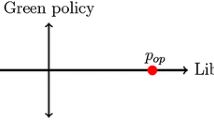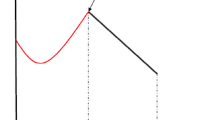Abstract.
A political–economic environment is studied in which two parties, representing different constituencies of citizens, compete over a proportional tax rate to be levied on private endowments, to finance a public good. Although parties know the distribution of citizen traits (preferences and endowments), they are uncertain about the distribution of traits among the citizens who will turn up at the polls. This uncertainty engenders an endogenously derived function π(t 1, t 2) giving the probability that any one tax policy t 1 will defeat another t 2 in the election. Equilibrium existence theorems are proved, and the nature of equilibrium is compared with the equilibrium that exists when Downsian parties (ones whose objective is to maximize the probability of victory) face uncertainty. Both constituency-representing parties and uncertainty are needed to generate equilibria in which parties propose different policies.
Similar content being viewed by others
Author information
Authors and Affiliations
Additional information
Received: 4 April 1995/Accepted: 2 April 1996
Rights and permissions
About this article
Cite this article
Roemer, J. Political–economic equilibrium when parties represent constituents: The unidimensional case. Soc Choice Welfare 14, 479–502 (1997). https://doi.org/10.1007/s003550050082
Issue Date:
DOI: https://doi.org/10.1007/s003550050082




